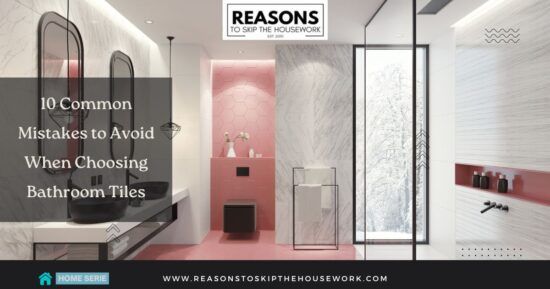Bathroom tiles can make or break your space—literally and aesthetically. With so many options in size, texture, color, and material, it’s easy to get overwhelmed and make choices you’ll regret later. A simple misstep could mean a slippery disaster, a maintenance nightmare, or a design that just doesn’t work.
If you want a bathroom that’s both stunning and functional, knowing what not to do is just as important as knowing what to do. To help you out, we’ve rounded up the most common tile mistakes and how to avoid them.

Contents
- 1. Ignoring Slip Resistance
- 2. Choosing the Wrong Size
- 3. Overlooking Maintenance Requirements
- 4. Clashing Colors and Patterns
- 5. Forgetting About Grout Color
- 6. Using the Same Tile Everywhere
- 7. Ignoring Tile Thickness
- 8. Poor Tile Placement
- 9. Not Ordering Extra Tiles
- 10. Skipping Professional Advice
- Final Thoughts
1. Ignoring Slip Resistance
Sure, that high-gloss tile looks gorgeous, but have you considered what happens when it gets wet? Bathroom floors see their fair share of moisture, making slip resistance a must. Opt for matte or textured tiles with a high slip rating, especially in the shower area. Because the last thing you want is a dramatic (and painful) fall in your spa-like oasis. Check out these expert-approved bathroom tiles to start your selection on the right foot (literally)
2. Choosing the Wrong Size
Bigger isn’t always better, but in the case of bathroom tiles, it often is. Many assume small tiles are ideal for compact spaces, but too many grout lines can make the room feel cluttered. Large-format tiles create a seamless, open look by reducing grout lines, making even tiny bathrooms feel spacious.
3. Overlooking Maintenance Requirements
That beautiful natural stone tile? It might require more maintenance than you bargained for. Porous materials like marble and limestone need sealing and regular upkeep, while ceramic and porcelain are low-maintenance champions. If you’d rather spend more time enjoying your bathroom than scrubbing it, choose wisely.
4. Clashing Colors and Patterns
Bold patterns and vibrant colors can add personality, but too many competing designs can turn your bathroom into a visual circus. Stick to a cohesive color palette and balance bold with subtle. A statement wall or mosaic feature can inject character without overwhelming the space. If you love a minimalist yet warm aesthetic, consider incorporating Japandi style, which blends Japanese simplicity with Scandinavian functionality—learn more about Japandi design here.
5. Forgetting About Grout Color
Grout might seem like an afterthought, but trust us—it makes a huge difference. Light grout stains easily, while dark grout adds contrast but can make a space feel busy. Neutral shades like light grey or beige often provide a happy medium between style and practicality.
6. Using the Same Tile Everywhere
Consistency is great, but a bathroom covered in one tile from floor to ceiling can feel flat and uninspired. Mix different textures, shapes, or sizes within the same color family to create visual interest. Think glossy wall tiles with matte floor tiles or a herringbone accent section for added depth.
7. Ignoring Tile Thickness
Not all tiles are created equal—literally. Floor tiles are typically thicker than wall tiles, and if you mix different thicknesses without proper planning, you’ll end up with uneven surfaces. Ensure your tiles are compatible or consult a professional to avoid a lopsided disaster.
8. Poor Tile Placement
Even the most stunning tiles can look terrible if installed poorly. Misaligned cuts, awkward patterns, or poorly placed focal points can ruin your bathroom’s design. Plan your layout carefully, focusing on symmetry, alignment with fixtures, and focal areas like the shower wall.
9. Not Ordering Extra Tiles
Running out of tiles mid-renovation is a nightmare. And trust us, finding an exact match later isn’t always easy. Always order 10–15% extra tiles to account for cuts, breakage, and future repairs. Better safe than scrambling to track down a discontinued style!
10. Skipping Professional Advice
DIY is great, but when it comes to bathroom tiles, expert input can save you money and stress. A designer or tiler can help you choose the best materials, layouts, and finishes to suit your space, lighting, and lifestyle. It’s a small investment for a polished, long-lasting result.
Final Thoughts
Choosing the right bathroom tiles isn’t just about aesthetics—it’s about safety, maintenance, and smart design choices. By avoiding these common mistakes, you’ll create a bathroom that looks amazing, functions well, and stands the test of time.
